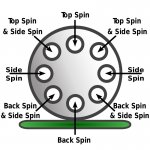I think you'd better look at that image again. The measles ball is the CB. The white ball is where the CB ended up after rebounding off the rail.
The measles ball can't follow the tangent line unless sliding upon contact with the 5. The natural rolling CB should rebound straight off the rail.
A rolling CB in this situation is a natural shot. Hitting middle CB with maximum right english deflects the CB and it fights natural CB roll.
EDIT :
SPARKIE... I set up the balls as in the image and I tried 10 shots your way.... and 10 my way. When you mentioned the
tangent line, I thought you were sending your CB down the stun line, and I now realize you weren't doing that.
All 20 shots worked... although your way actually came down table nearer to the rail than my way. My "rolling CB" did
need some top right to get to center table, but may be preferable if the CB needs more angle off a rail for shape.
.
I'll take one more stab at explaining this. I am well aware of which ball is the CB.
It makes virtually no difference where the CB is struck on either the vertical or horizontal axis. When the CB strikes the object ball it will come off the OB along the tangent line. That's Pool 101. As the CB proceeds along the TL it may or may not deviate from that path. When said deviation occurs, it is speed dependent. Stun &/or forward roll causes no deviation. Topspin cause curve in the same direction as the OB was cut and backspin in the opposite direction. Every shot, no matter how it's hit, unless it hits something to halt its progress, eventually turns into a naturally rolling ball. It should be evident that a naturally rolling ball will not curve off its natural path.
Sidespin is irrelevant until the CB contacts a rail, with the following caveat. If the CB is going very slowly, with a ton of spin, it will pull slightly in the direction of the spin.
So with the shot in question here, unless it's hit very softly with topspin, it will stay on the TL till it hits the rail.
To say that the CB can't or won't follow the TL unless it's sliding is unequivocally false.
The only way to cause a bit of deviation in where contact with the short rail occurs, is to hit softly with good draw or follow, or to overcut the OB into the far right side of the pocket. (That's one big problem with examples such as this. With the ball so close and directly out from the middle of the pocket, how much the ball is cut will dramaticly affect both direction and speed.
Whenever I comment on these things I always base my analysis on the OB going in the center of the pocket. In this case noone should have any trouble determining where on the rail the tangent line brings you. In describing how to shoot this shot you'll note I said to hit it "firmly" with middle right. In which case there is no question the CB will continue on the TL until contacting the rail. Given that the angle is 35-40 degrees, I'd think most would agree that you need a lot of right to come straight back up table.
All that aside, my main reason for the post, was to clarify that your description of reverse had nothing to do with Fran's intended meaning, and as such, was inaccurate and confusing (to some) information. That's why I said your statement was a misrepresentation.
